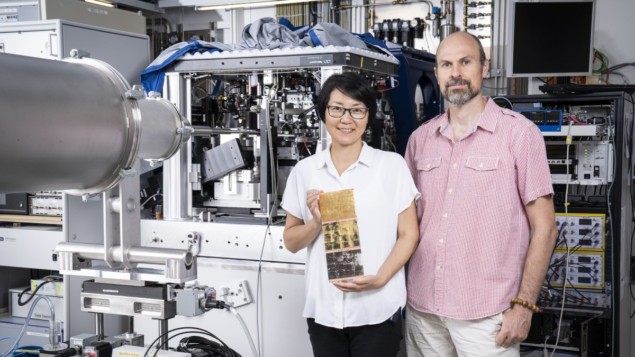
Using an advanced, non-invasive imaging technique, researchers in Switzerland and Germany have shed new light on a metal-leaf material that was widely used for gilding sculptures in medieval Europe. By processing a series of X-ray diffraction patterns, the team produced ultra-precise images of the material’s interior nanostructure. The analysis could help conservators of medieval art to better preserve sculptures against degradation.
The research was done by a team led by Qing Wu at the University of Applied Sciences and Arts of Western Switzerland and Benjamin Watts at the Paul Scherrer Institute. The study was done on the cSAXS beamline at the PSI’s Swiss Light Source.
In the late Middle Ages, many sculptures and religious artefacts were decorated with zwischgold, which is a highly sophisticated material comprising an ultrathin gold layer that is backed by a thicker layer of silver. This material is far stronger and less costly than pure gold leaf. However, unlike pure gold, zwischgold will corrode. When exposed to air, silver atoms in the backing layer will diffuse through the gold layer to react with sulphur and chlorine, causing the leaf to blacken over time.
Lost metallurgical techniques
While this process can be slowed by applying a varnish to the sculpture, this protective layer will degrade over centuries. As a result, many medieval sculptures require careful restoration. Conservation presents a further challenge because the advanced metallurgical techniques used to produce the nanostructured material have been lost to time.
In their study, Wu, Watts and colleagues learned more about the zwischgold’s unique nanostructure using ptychographic X-ray computed tomography (PXCT). This is a recently developed technique that produces full 3D images of samples using X-ray scattering. By processing diffraction patterns, PXCT can detect nanoscale variations in a sample’s interior refractive index, providing some of the highest resolutions of all X-ray imaging techniques.

Solving the mystery of the Alhambra’s purple gold
The team used PXCT to analyse a small sample taken from a 15th century sculpture of Mary holding the baby Jesus, which is displayed at the Swiss National Museum in Zurich. Their analysis clearly showcased the skill of the medieval artisans who produced the material by beating the two delicate layers into each other to within nanoscale precision. The team also examined other examples of zwischgold, including a rare variant of the material that comprises multiple, extremely thin gold layers.
The study revealed that the gold layer in zwischgold is about 30 nm thick, compared to gold leaf, which is typically 140 nm. This illustrates the cost saving of using the gold and silver hybrid.
The researchers found that over the centuries, corrosion causes zwischgold leaf to become less dense and more porous. The team also observed the separation of the gold and silver layers as well as the separation of the zwischgold from the underlying sculpture. This new understanding of how zwischgold degrades over time could help conservators to refine their techniques to restore medieval sculptures more effectively – preserving them for future generations to appreciate.
The research is described in Nanoscale.


